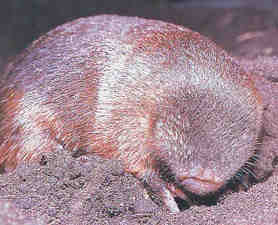It looks like you're using an Ad Blocker.
Please white-list or disable AboveTopSecret.com in your ad-blocking tool.
Thank you.
Some features of ATS will be disabled while you continue to use an ad-blocker.
6
share:
I have seen iridescence in many birds, but this is a first for a mammal.
news.discovery.com...

I wonder if there are any other iridescent mammals that we have yet to discover?
news.discovery.com...
The fur of golden moles has multiple layers that act as reflectors similar to the "eye shine" of nocturnal mammals.

The moles are completely blind, so the iridescence likely serves a function other than communication.
The microscopic structure of the hairs may facilitate the mole's movement underground through dirt and sand.
Aside from the “eye shine” of nocturnal mammals, seen when a headlight or flashlight strikes their eyes, the discovery marks the first known instance of iridescence in a mammal. The findings, published in the latest Royal Society Biology Letters, reveal yet another surprise: the golden moles are completely blind, so they cannot even see their gorgeous fur.
For the study, the scientists pulled hairs from specimens of four golden mole species. Using high tech equipment, such as scanning electron microscopy and transmission electron microscopy, the researchers analyzed the structure of the hairs, down to their smallest elements.
The researchers determined that the hairs are indeed luminescent. They further discovered that each hair has a flattened shape with reduced cuticular scales that provide a broad and smooth surface for light reflection. The scales form multiple layers of light and dark materials of consistent thickness, very similar to those seen in iridescent beetles.
I wonder if there are any other iridescent mammals that we have yet to discover?
reply to post by isyeye
I once saw a hedgehog that was covered in rave paint - it was luminous green! To this day i still haven't worked out whether it was an act of outright cruelty or simply a misguided clubber who thought they were doing the hedgehog a favour (it was in the middle of the road when i saw it). Im guessing thats not the sort of irridescent you mean though?
Nice spot and thanks for posting this. It does raise questions as to what the purpose is for a blind creature! The link they are suggesting to its ability to burrow is certainly intriguing - among other things does this mean we should making irridescent miners?
I once saw a hedgehog that was covered in rave paint - it was luminous green! To this day i still haven't worked out whether it was an act of outright cruelty or simply a misguided clubber who thought they were doing the hedgehog a favour (it was in the middle of the road when i saw it). Im guessing thats not the sort of irridescent you mean though?
Nice spot and thanks for posting this. It does raise questions as to what the purpose is for a blind creature! The link they are suggesting to its ability to burrow is certainly intriguing - among other things does this mean we should making irridescent miners?
Perhaps these creatures have the ability to perceive waves of light, kind of like how birds have geomagnetic sensors. Or the light they generate
causes one of their natural predators to be blinded by the light. So many possibilities! Very interesting OP!
Wow! Awesome! I had to chuckle because when I was a kid I found a mole and thought it was a mouse without any eyes and felt so bad. LOL
new topics
-
Paradox of Progress
Ancient & Lost Civilizations: 4 hours ago -
Joe Biden gives the USA's Highest Civilian Honor Award to Hillary Clinton and George Soros.
US Political Madness: 6 hours ago -
Winter Storm
Fragile Earth: 7 hours ago -
Biden Face Planted Somewhere
Politicians & People: 9 hours ago -
A great artist and storyteller, for kids of all ages
General Entertainment: 9 hours ago
top topics
-
Joe Biden gives the USA's Highest Civilian Honor Award to Hillary Clinton and George Soros.
US Political Madness: 6 hours ago, 13 flags -
What Is 'Quad Demic'? Mask Mandate Returns In These US States
Diseases and Pandemics: 13 hours ago, 11 flags -
Volcano Watch 2025
Fragile Earth: 15 hours ago, 8 flags -
The Future of fashion .
Social Issues and Civil Unrest: 14 hours ago, 8 flags -
Winter Storm
Fragile Earth: 7 hours ago, 7 flags -
Bin Cyber Junk…
Short Stories: 14 hours ago, 6 flags -
Biden Face Planted Somewhere
Politicians & People: 9 hours ago, 5 flags -
A great artist and storyteller, for kids of all ages
General Entertainment: 9 hours ago, 5 flags -
Paradox of Progress
Ancient & Lost Civilizations: 4 hours ago, 5 flags -
The Undertones - Teenage Kicks
Music: 15 hours ago, 3 flags
6
